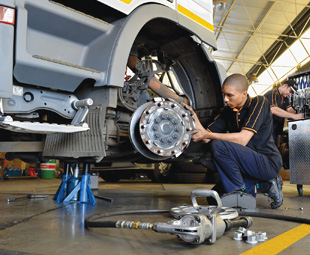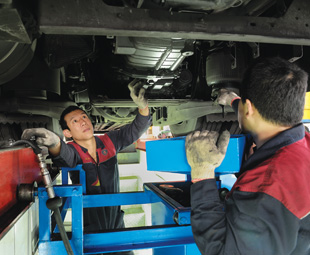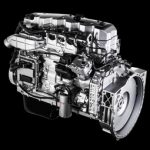Micromanaging maintenance

We go through the nuts and bolts of choosing to maintain vehicles on site or sending them to a dealer, and ask how to ensure that skilled hands are managing the wrenches.
In the transport industry, reliable, well-maintained trucks are the lifeblood of an operator’s business. If something happens in some far-flung corner of the country, immediate backup is required to get the vehicle back on the road and to its destination. This backup, together with the general maintenance of the vehicle, is often provided by the vehicle original equipment manufacturer (OEM), but, in some cases, it is undertaken by the operating company itself.
How do you decide which option is right for you? And how do you ensure that the technicians working on your vehicles have the most up-to-date and relevant skill set to keep the wheels rolling?
Which way to go?
It would seem that the majority of the country’s transport operators choose to have their vehicles maintained within the OEM dealer network, “… at least for the Warranty period,” says Scania South Africa service director, Steen Gram. “Through after-sales products and service offerings tailor-made to customer needs, we see more and more operators choosing the OEM to maintain their vehicles.”
Isuzu Truck South Africa national service manager, Wayne Morgan, agrees. “Most customers don’t have the infrastructure to service vehicles themselves and, when comparing the cost to purchase or build premises and equip them accordingly, franchise servicing is a better option.”
Kgaogelo Sebothoma, service and technical manager for Fuso Trucks at Daimler Truck & Bus, says: “The dealer network possesses the brand-specific technical expertise to execute service, maintenance and repairs on its brand of vehicles, but, for some operators, it may be more convenient and cost-efficient to maintain vehicles on site.”
While the advantages of dealer servicing are undeniable (well-skilled technical support, repair and maintenance contracts, breakdown support, enhanced resale value with a dealer full service history), maintaining a vehicle on site is, in fact, sometimes the only option.
“Operators within the passenger transport sector (commuter buses) have scheduled operating times and the demand on the OEM is for on-site servicing and repairs. Operators in the specialised application sector would demand on-site servicing as well,” says Gram.
Morgan adds: “Government institutions and vehicles operating within the mining industry have very strict rules for leaving the premises. Most truck rental companies undertake their own servicing, as the vehicles are their core business and the structure of their business caters for a workshop, and usually includes a vehicle repair section.”
What would I need?
Before diving in, Gram advises some careful consideration of certain issues. “There are a number of factors to consider before setting up an on-site workshop, namely; fleet size, customer location, space, tooling and equipment requirements and the legal aspects. If Scania has located staff at the customer’s premises, they can expect the same service level that we offer in a workshop, but on a smaller scale,” Gram says.
 Sebothoma adds that staff (technicians and foremen), safety equipment, workshop literature and brand-specific knowledge are imperative.
Sebothoma adds that staff (technicians and foremen), safety equipment, workshop literature and brand-specific knowledge are imperative.
Depending on the brand of vehicles in the fleet, certain OEM requirements for on-site servicing will also need to be satisfied – though most OEMs will work with the customer, not against them … “We offer some of our customers an agreement to provide their own service with very strict guidelines, but, if a customer has been approved to conduct their own servicing, the level of support from the manufacturer is the same as from a dealer,” Morgan explains.
Knowing your torque wrenches from your trolley jacks
Morgan warns, though, that finding the right staff is not as easy as one might hope. “Customers also realise that technology is changing at such a rate that finding skilled staff to maintain vehicles is very difficult and adds to the pressure of the transport business, which is already one of the most difficult industries in which to operate.”
Ideally, says Gram, technicians should have a trade test qualification; including an N3 Certificate and three to five years of working experience. They should state what jobs they’ve performed (engine repairs/service and maintenance/gearboxes/wheel alignment, and so on). “If they have attended other training courses, such as OEM or health and safety training, this is also advantageous.”
“We have found that the best way to employ technicians is through a four-year apprentice programme, where the apprentice works within a service facility learning from a journeyman. At the end of the apprenticeship, the skills base can be assessed,” Morgan says.
“Technicians need to undergo dedicated training programmes and continuous assessment; even those who are highly skilled,” Sebothoma points out. Individual OEMs have specific training requirements and offer theoretical and practical modules in order for technicians to work on their vehicles.
Making the right decision
Vehicle operators are exceptionally savvy; knowing what they need from their vehicles, what they expect from the OEM and how to crunch the numbers for optimal costs and profits. Deciding on which servicing and maintenance route to pursue is a decision to be considered wisely and in partnership with the OEM. |FOCUS
Can you not worry about maintenance at all?
Full maintenance leasing (FML) is an option fast on the rise with companies running fleets of smaller vehicles.
“FML is like an operating lease. The vehicle is owned by the financier, from whom the user rents, but with one crucial difference – with FML, the financier carries the responsibility and risks of maintaining the vehicle; including failures, breakdowns and tyres.” says David Molapo, head of Fleet Management at Standard Bank. “These costs are built into the monthly rental, which remains the same no matter how many times the vehicle needs maintenance. At the end of the contract the risk of disposal resides with us.”
FML vehicles are leased over a certain period and for a certain distance (for example, 36 months/
120 000 km). The contract usually comes to an end when these parameters are reached, but extensions can be negotiated.
There are measurable benefits to FML. It can allow a company to lease the exact number of vehicles required for each contract won, making costing and tendering and project management easier. “Overheads are kept to a minimum – when there is no project, there is no vehicle,” explains Carike Bessinger, financial administrator from Ansys Limited.
Belinda Olivier, fleet overseer at Dynamic Instruments, says that FML is more cost-effective in the long term due to the tax advantages of not having to buy vehicles as company assets. Olivier says FML had instilled new discipline into the company to avoid repair charges from the financier when the time comes to hand back the vehicles. Each driver is held responsible for unreported damage to the vehicle that he drives.
Olivier says that FML only makes sense for the light vehicles used by the company. “The heavy-duty trucks used by the company, often fitted with cranes, last so long that it pays to purchase them outright.”
Published by
Focus on Transport
focusmagsa




